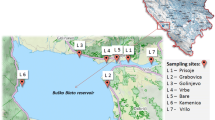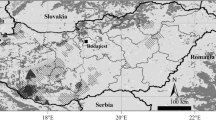Abstract
We have examined variability inTaqI andEcoRI restriction fragment sizes of DNA from the koala (Phascolarctos cinereus) using six HVR (hypervariable region) probes which reveal complex, individual-specific restriction patterns in humans and other species. Frequency of band-sharing among unrelated koalas was extremely high. This result is likely to be a consequence of the history of near-extinction and artificial recolonization of the populations we have studied, rather than a general marsupial or koala-wide phenomenon.
Similar content being viewed by others
References
Bell, G. I., Selby, M. J., and Rutter, W. J. (1982). The highly polymorphic region near the human insulin gene is composed of simple tandemly repeating sequences.Nature 29531.
Burke, T., and Bruford, M. W. (1987). DNA fingerprinting in birds.Nature 327149.
Burke, T., Davies, N. B., Bruford, M. W., and Hatchwell, B. J. (1989). Parental care and mating behaviour of polyandrous dunnocksPrunella modularis related to paternity by DNA fingerprinting.Nature 338249.
Dallas, J. F. (1988). Detection of DNA “fingerprints” of cultivated rice by hybridization with a human minisatellite DNA probe.Proc. Natl. Acad. Sci. USA 856831.
Feinberg, A. P., and Vogelstein, B. (1983). A technique for radiolabelling DNA restriction endonuclease fragments to high specific activity.Anal. Biochem. 1326.
Flint, J., Boyce, A. J., Martinson, J. J., and Clegg, J. B. (1989). Population bottlenecks in Polynesia revealed by minisatellites.Hum. Genet. 83257.
Georges, M., Lequarre, A.-S., Castelli, M., Hanset, R., and Vassart, G. (1988). DNA fingerprinting in domestic animals using four different minisatellite probes.Cytogenet. Cell Genet. 47127.
Gilbert, D. A., Lehman, N., O'Brien, S. J., and Wayne, R. K. (1990). Genetic fingerprinting reflects population differentiation in the California Channel Island fox.Nature 344764.
Gyllensten, U. B., Jakobsson, S., Temrin, H., and Wilson, A. C. (1989). Nucleotide sequence and genomic organization of bird minisatellites.Nucl. Acids Res. 172203.
Hoelzel, A. R., and Amos, W. (1988). DNA fingerprinting and “scientific” whaling.Nature 333305.
Jarman, A. P., Nicholls, R. D., Weatherall, D. J., Clegg, J. B., and Higgs, D. R. (1986). Molecular characterization of a hypervariable region downstream of the human á globin gene cluster.EMBO J. 51857.
Jeffreys, A. J., and Morton, D. B. (1987). DNA fingerprints of dogs and cats.Anim. Genet. 181.
Jeffreys, A. J., Wilson, V., and Thein, S. L. (1985a). Hypervariable “minisatellite” regions in human DNA.Nature 31467.
Jeffreys, A. J., Wilson, V., and Thein, S. L. (1985b). Individual-specific ‘fingerprints’ of human DNA.Nature 31676.
Jeffreys, A. J., Wilson, V., Kelly, R., Taylor, B. A., and Bulfield, G. (1987). Mouse DNA “fingerprints”: Analysis of chromosome localization and germ-line stability of hypervariable loci in recombinant inbred strains.Nucl. Acids Res. 152823.
Knott, T. J., Wallis, S. C., Pease, R. J., Powell, L. M., and Scott, J. (1986). A hypervariable region 3′ to the human apolipoprotein B gene.Nucl. Acids Res. 149215.
Nakamura, Y., Leppert, M., O'Connell, P., Wolff, R., Holm, T., Culver, M., Martin, C., Fujimoto, E., Hoff, M., Kumlin, E., and White, R. (1987). Variable number of tandem repeat (VNTR) markers for human gene mapping.Science 2351616.
Ramus, S., Martenson, J. S., Taylor, A. C., Graves, J. A. M., O'Brien, S. J., Murray, N. D., and Sherwin, W. B. (1991). Conservation genetics of the Koala I. Allozyme variation and the genetic effects of relocations in southeastern Australia (submittedAust. Wildl. Res.).
Reeders, S. T., Breuning, M. H., Davies, K. E., Nicholls, R. D., Jarman, A. P., Higgs, D. R., Pearson, P. L., and Weatherall, D. J. (1985). A highly polymorphic DNA marker linked to adult polycystic kidney disease on chromosome 16.Nature 317542.
Reeve, H. K., Westreat, D. F., Noon, W. A., Sherman, P. W., and Aquadro, C. F. (1990). DNA “fingerprinting” reveals high levels of inbreeding in colonies of the eusocial naked mole-rat.Proc. Natl. Acad. Sci. USA 872496.
Robinson, N. A., Sherwin, W. B., Murray, N. D., and Graves, J. A. M. (1990). Applications of conservation genetics to the Eastern Barred Bandicoot,Perameles gunnii. In T. Clarke and J. H. Seebeck, (eds.), Management of Small Populations. Chicago Zoological Society, Brookfield, Ill., USA, pp. 109–131.
Rogstad, S. H., Patton, J. C., II, and Schaal, B. A. (1988). M13 repeat probe detects DNA minisatellite-like sequences in gymnosperms and angiosperms.Proc. Natl. Acad. Sci. USA 859176.
Sherwin, W. B., and Murray, N. D. (1989). Population and conservation genetics of marsupials.Aust. J. Zool. 37161.
Shin, H.-S., Bargiello, T. A., Clark, B. T., Jackson, F. R., and Young, M. W. (1985). An unusual coding sequence from aDrosophila clock gene is conserved in vertebrates.Nature 317445.
Stoker, N. G., Cheah, K. S. E., Griffin, J. R., Pope, F. M., and Solomon, E. (1985). A highly polymorphic region 3′ to the human Type II collagen gene.Nucl. Acids Res. 134613.
Vassart, G., Georges, M., Monsieur, R., Brocas, H., Lequarre, A. S., and Christophe, D. (1987). A sequence in M13 phage detects hypervariable minisatellites in human and animal DNA.Science 235683.
Vernick, K. D., and McCutchan, T. F. (1988). Sequence and structure of aPlasmodium falciparum telomere.Mol. Biochem. Parasitol. 2885.
Warneke, R. (1978). The status of the koala in Victoria. In Bergin, T. J. (ed.),The Koala Zool. Parks Brd., N.S.W., Sydney.
Wetton, J. H., Carter, R. E., Parkin, D. T., and Walters, D. (1987). Demographic study of a wild house sparrow population by DNA fingerprinting.Nature 327147.
Wildt, D. E., Bush, M., Goodrowe, K. L., Packer, C., Pusey, A. E., Brown, J. L., Joslin, P., and O'Brien, S. J. (1987). Reproductive and genetic consequences of founding isolated lion populations.Nature (London) 329328.
Wyman, A., and White, R. (1980). A highly polymorphic locus in human DNA.Proc. Natl. Acad. Sci. USA 776754.
Author information
Authors and Affiliations
Additional information
This work was funded by the Australian Research Council.
Rights and permissions
About this article
Cite this article
Taylor, A.C., Graves, J.A.M., Murray, N.D. et al. Conservation genetics of the koala (Phascolarctos cinereus) II. Limited variability in minisatellite DNA sequences. Biochem Genet 29, 355–363 (1991). https://doi.org/10.1007/BF00554143
Received:
Revised:
Issue Date:
DOI: https://doi.org/10.1007/BF00554143




